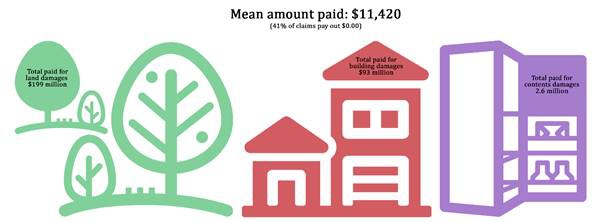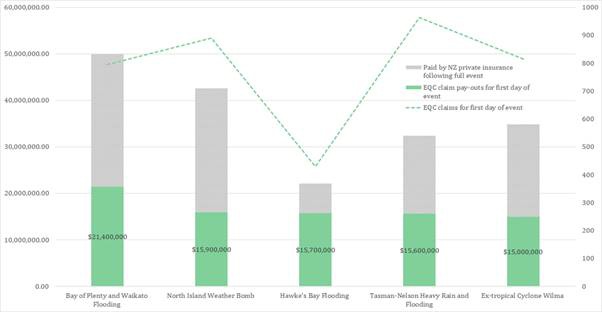EQC flood claims come from the rich and close to the coast
EQC flood claims come from the rich and close to the coast: A Motu Media Release
Since the turn of the century, more than 25,000 claims worth nearly $300 million have been paid out by the Earthquake Commission (EQC) for damages caused by wild weather.
“With climate change it’s vital to know how weather-related events translate into financial liabilities for the Crown,” said Professor Ilan Noy, one of the authors of the research published by Motu Economic and Public Policy Research today. “This is the first in-depth analysis of EQC claims for weather-related events and is the beginning of understanding what we may face in the future.”
EQC covers homeowners for damage to land (and in some cases to dwellings and contents) caused by landslip, storm or flood. Between 2000 and 2017, the mean amount paid out to claimants was $11,420.
“The total paid for land damages was $199 million, for building damage it was $93 million and $2.6 million was paid out for damages to contents,” said Professor Noy. “Only houses with private insurance can receive a payout from EQC and there are some strict constraints on what is covered, so 41 percent of claimants didn’t get any money.”

Around a third of the total number of payouts by EQC were in response to five events:

“Locations with a median income in the top forty percent of incomes tend to report more than half of the total claims and pay-outs made. This suggests that, after extreme weather events, higher-income families make more frequent use of EQC insurance and claim more payment than the average New Zealand family,” said Professor Noy.
The reasons for this increase in EQC pay-outs associated with higher income households are not yet entirely clear. They could be associated with better access to the system, higher exposure due to location preferences of various income groups, or higher damages caused by higher asset values (e.g. larger homes and larger housing footprints).
While the average property in NZ is approximately 11km away from the coast, the average property lodging a claim to EQC after a weather event is located only 6km away.
“We are only just beginning to provide insights about the increasing risk that current and future residential areas might face, given the possibility of increasing frequency of extreme weather events,” said Professor Noy.
“This paper is the first part of research
which we hope will ultimately project the financial
liability from climate change for EQC, and through it, the
Crown” said Professor Noy.
The full working paper
“Public insurance and climate change (part
one): Past trends in weather-related insurance in New
Zealand” by David A. Fleming, Ilan Noy, Jacob
Pástor-Paz and Sally Owen is now available on the Motu
website. It was funded by the Ministry of Business,
Innovation and Employment through the Deep South National
Science Challenge’s Impacts and Implications Programme and
the Resilience National Science Challenge.
Summary
haiku:
Climate change concern:
many
insurance claims from
weather
already.
-ends-
About Motu
Motu Economic and
Public Policy Research is an independent economic
research institute which never advocates an expressed
ideology or political position. A charitable trust, Motu is
founded on the belief that sound public policy depends on
sound research accompanied by well-informed and reasoned
debate.
Motu is the top-ranked economics organisation in New Zealand. It is in the top ten global economic think tanks, according to the Research Papers in Economics (RePEc) website, which ranks all economists and economic research organisations in the world based on the quantity and quality of their research publications. It also ranks in the top ten climate think tanks in the world according to the International Center for Climate Governance.
Figures for EQC claims and payouts for specific weather-related events
| Weather event | characteristics | EQC claims for first day of event | EQC claim pay-outs for first day of event | Paid by NZ private insurance following full event |
| Bay of Plenty and Waikato Flooding | heavy rain | 795 | $21,400,000 | $28,500,000 |
| North Island Weather Bomb | high winds, seas and rainfall in several regions of the country | 890 | $15,900,000 | $26,700,000 |
| Hawke's Bay Flooding | four days of heavy rain | 429 | $15,700,000 | $6,400,000 |
| Tasman-Nelson Heavy Rain and Flooding | no description | 964 | $15,600,000 | $16,800,000 |
| Ex-tropical Cyclone Wilma | two days of heavy rain affecting the north of the country | 815 | $15,000,000 | $19,800,000 |


 Gordon Campbell: On bird flu, AUKUS entry fees and Cindy Lee
Gordon Campbell: On bird flu, AUKUS entry fees and Cindy Lee NZ Government: New Lab To Help Protect Key Pacific Tuna Fisheries
NZ Government: New Lab To Help Protect Key Pacific Tuna Fisheries Susan Botting - Local Democracy Reporter: Ruawai Leader Slams Kaipara Council In Battle Over $400k Property
Susan Botting - Local Democracy Reporter: Ruawai Leader Slams Kaipara Council In Battle Over $400k Property Te Pati Maori: Another ‘Stolen Generation’ Enabled By Court Ruling On Waitangi Tribunal Summons
Te Pati Maori: Another ‘Stolen Generation’ Enabled By Court Ruling On Waitangi Tribunal Summons Peace Action Wellington: Die In for Palestine Marks ANZAC day
Peace Action Wellington: Die In for Palestine Marks ANZAC day Labour Party: Penny Drops – But What About Seymour And Peters?
Labour Party: Penny Drops – But What About Seymour And Peters? Government: PM Announces Changes To Portfolios
Government: PM Announces Changes To Portfolios


